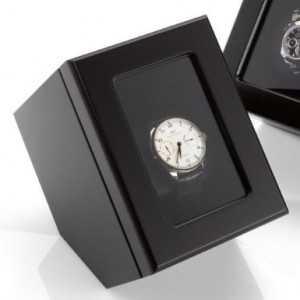Beginning watch collectors are often confused when learning about watch winders for the first time. These devices, bluntly put, seem unnecessary.
Why spend hundreds or sometimes thousands of dollars on a box that does little more than rotate a row of watches?
Understanding the rationale behind a watch winder requires an understanding of automatic watch operation.
How Automatic Watches Work
Watch winders are more formally known as automatic watch winders expressly designed for automatic watches. Unlike battery power quartz watches or manually wound watches, automatic watches are powered by the natural motion of the wearer’s wrist.
As the watch owner’s arm swings back and forth during the day while walking, the rotor inside the watch swings in a contrary motion, then returns to its center of gravity.
During its return to center, its axle turns the watch’s mainspring—a coil of flat wire that applies pressure to the gear train—as the coil expands outward.
So the mainspring is being agitated throughout the day, obviating the need for manual winding.
For owners of a single automatic watch, the self-winding mechanism presents no problem, but watch enthusiasts purchase multiple watches the same way others buy multiple shoes or suits.
This means that at any given time, most of their watches aren’t being worn. Since a full winding seldom powers a watch for more than a day or two, watch collectors would have to constantly reset and wind each watch before wearing it.
For a collection of half a dozen watches, this quickly becomes irritating and unmanageable.
Using Watch Winders
Watch winders look like fancy watch boxes that animate the watches they hold, but the reason is more functional than visual. Watch winders are designed to replicate the external motion that automatic watches would otherwise receive from the wearer’s arm, so that they don’t slow to a halt.
The simplest watch winders are cheap models that rotate in one direction at one speed. These should be avoided in almost every case, since they risk over winding the mainspring, rendering it too flaccid to drive the gears.
Automatic watches need the same variety in the duration, speed and direction of movement that they would ordinarily get from their owner.
Quality watch winders have clockwise (CW), counterclockwise (CCW), and bidirectional (BD) rotation settings. They also allow the user to adjust the number of turns per day (TPD).
These parameters are crucial for high-end watches, since each model has different mechanics, different sensitivities, and therefore different configuration requirements for direction and speed.
For instance, a Louis-Vutton watch requires 650 to 800 BD TPD, while a an Invicta watch require a minimum of 800 CW or BD TPD.
The best watch winders also have timers for setting the duration and start delay of rotation. Delaying the winding provides the mainspring a chance to discharge any excess tension if the watch has been recently worn.
Technically, watch winders might be luxuries, but they’re highly useful luxuries. They not only keep your automatic watches properly wound, but distribute the tension and lubrication in watches more evenly, which reduces the amount of maintenance necessary.


